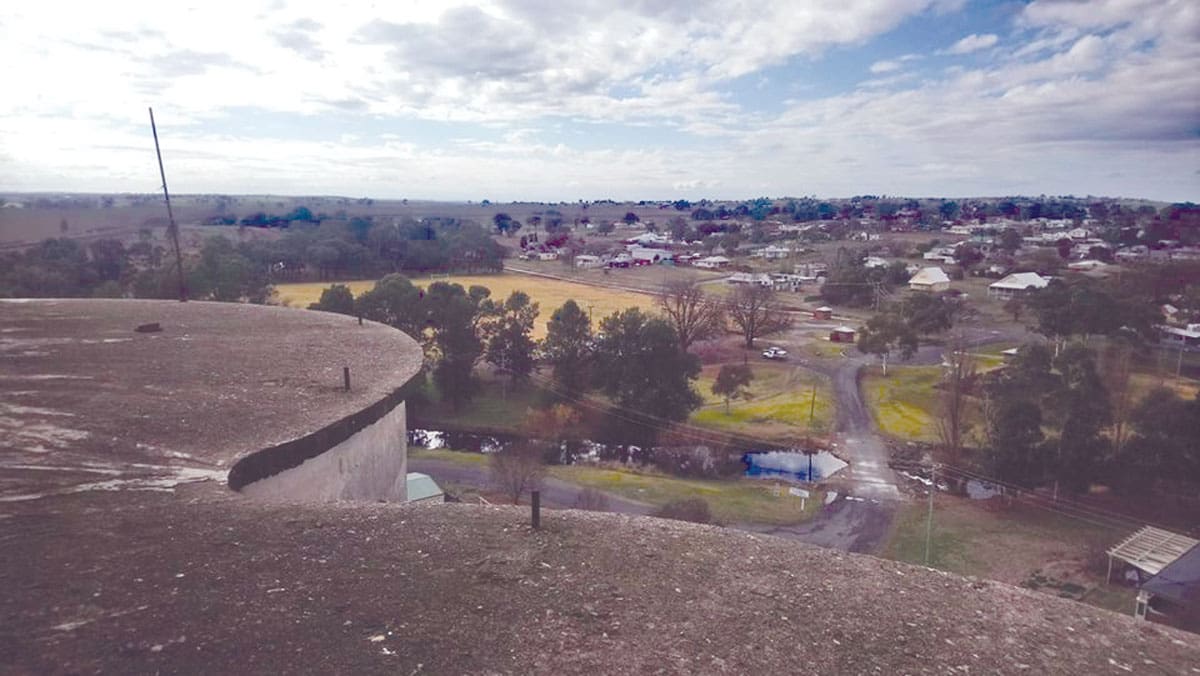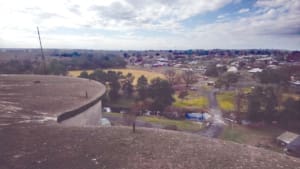A very rare photograph taken by Robert Scott from atop the Murrumburrah Mill looking in an eastward direction. You can see Murrimboola creek, Robert’s Park and the lower end of Murrumburrah. The Times will be printing a series of stories about our local history with the first instalment this week.
With its historical significance Murrumburrah could become the jewel in the crown of Hilltops Council because it’s the only village in our locality to have attained ‘official historical’ status. That’s provided we use turn this village into an historic town. Murrumburrah to date has never declared or used its ranking. This is a travesty because acknowledgment and historical development of our village could have brought much-needed employment. This argument is especially convincing when one considers the fortunes of towns like Berrima and Coolamon NSW. Both are registered historical towns and have ridden on the backs of their past. Both have immensely profited economically as well as substantially increasing employment. And this is despite being off the grid from major roads and rail networks that lead directly to large cities.
Currently both historic towns receive every year healthy numbers of visitors from Australia as well as from overseas. Berrima is widely recognized today as being the best preserved example of a Georgian village on the Australian mainland while Coolaman is known for its handmade cheeses, classic country pubs and charming heritage buildings, as well as the Lamson cash railway system, the only ball-style cash carrier in the world still in its original location. The Lamson cash system consists of wooden balls which carry cash from shop assistants to the cashier and back. These balls run along sloping rails. Unlike Berrima and Coolamon, Murrumburrah is on a main road and also has close access to the Sydney/Melbourne rail system which gives this town distinct advantages.
The father of European settlement in Murrumburrah (formerly known as Murrumboola) was Irishman Miles Murphy who was a carpenter. When gold was discovered at Lambing Flat, Murphy saw a window of opportunity and subsequently set up stores on the goldfields and commenced a coach service. He later moved his businesses to Murrumboola which was sited on his farm “Murrumburra’. The name Murrumburrah comes from his sheep station (despite an ‘h’ being added) which was established in the district in the late 1820s. On 12 March 1856, Miles Murphy applied to purchase two half-sections of his licensed ‘Murrumburra’ farm. Almost immediately Cunningar applied for village status but after much correspondence ‘Murrumburra’ was decided upon as the better site, mainly due to its better water facilities and being at the intersection of the Wagga Wagga to Sydney, Gundagai and the lower Murrumbidgee roads.
In those days ‘Murrumburra’ included a public house (The White Horse Inn), a store, a black smith’s shop, a few dwellings, numerous huts and about 25 acres of wheat paddocks and gardens. In order to outsmart the bushrangers often businesses and many settlers safeguarded their money by cutting their bank notes in half, sending one half to their bank on one mail coach and the other half on board the next coach. In 1863 Miles Murphy built Murrumburrah Flour Mill (on the present site in Albury Street), then sold it to Thomas Allsop in 1868 who not only modernized it but also increased it’s size; turning the Mill into an award- winning establishment. When the town was gazetted in 1858 it was named Murrumburrah. Harden was formerly known as Murrumburrah North however, in 1880 the New South Wales Postmaster-General so as to ensure the post didn’t go astray, renamed it the County of Harden. To be Continued. Robin Cooper.




